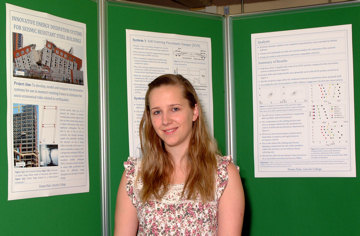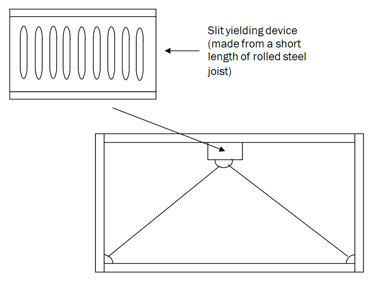| Issue 10 |
This year the prizes were sponsored by civil engineers Laing O'Rourke, by IC engine experts Ricardos, (both of these for the first time), and by Glaxo Smith Kline and Sony Broadcast & Professional. There were fourteen entries, a slightly disappointing number - twenty to twenty-five would have been better, but the number does vary somewhat from year to year. And the exhibition was in the sixth week of Trinity Term, two or three weeks later than usual, which may have had some effect.
The judges were, as usual, a selection of fairly recent graduates, now engineers in the "real world", namely:
Mark Gooding, Merton 1996-2000, now with Mirada Medical
Richard Lane, Oriel 1996-2000, now working on radar with QinetiQ
Margot Mear, New College 2001-5, now a civil engineer with Atkins
Mike Parker, Keble 1994-8, now a semiconductor engineer with STMicroelectronics.
They awarded prizes as follows:

|
Emma Hale of Lincoln (above) got the £600 Laing O'Rourke prize for the best civil or constructional engineering exhibit. Her work was on Innovative Energy Dissipation Methods for making steel-framed buildings more resistant to earthquakes. It was a computer-based study, and concluded that the best of the techniques she studied was to incorporate short lengths of RSJ with cross-wise slits in the web. They were arranged so that if the building frame was distorted from its normal rectangular shape, the flanges of these little RSJs slid in opposite directions and the web yielded plastically, dissipating energy and thus damping oscillations. See figure below.

|
| One bay of a multi-storey steel-framed building, incorporating the slit yielding device to reduce earthquake damage |

|
Kirsty McNaught of LMH (above) got the £300 Sony Image Processing prize for an exhibit about a computer program to assess the state of wounds (to the feet in the example shown) by analysing images of them. This was a project done in collaboration with Eykona Technologies. She found that she got the best results by doing Fast Fourier Transforms on the colour (RGB) signals from arrays of 7 x 7 pixels.

|
Jeremy Evans of St John's (above) exhibited a complex computer program for finding the best way to generate a clean water supply in poor countries, taking account of numerous different factors: rainfall, proximity of the water source, pollution, population etc. Depending on circumstances, the optimum solution might vary from simply ladling it out of the river with a bucket, to much more complex pumping and piping arrangements. Jeremy treated his visitors to an extended demonstration, and the judges thought this was the best exhibit of the lot, and awarded him a £750 prize.
Andrew Pitayanukul of Magdalen was awarded a "best poster" prize of £200 for an exhibit concerned with the new "ballistic" way of administering drugs or vaccines, projecting them through the skin from behind a bursting diaphragm, an alternative to needle injection. He described an acoustic method for assessing how well the drug had been assimilated, by seeing how rapidly the solid particles diminish in size as they dissolve.
Ian Ashcroft of LMH had another water-supply exhibit, but his project was very different from that of Jeremy Evans. It described a doubling-acting hydraulic ram pump for getting water from bore-holes too deep for it to be sucked up from the top. Unlike the more familiar ram pump, it had a mechanical input, but it still used the ram effect to generate high transient pressures. Water was made to flow in alternate directions along a pipe, carrying a "shuttle" with it. When the shuttle hit its end-stops the flow was brought instantly to rest. The high pressures generated by this deceleration allowed water to flow through non-return valves into the outlet pipe, where it was stored briefly in a high-head accumulator. Following a design study, the pump had actually been built and tested, but unfortunately could not be transported to the exhibition room. Nevertheless the judges awarded him a £150 "best hardware" prize, which seemed well-deserved. Only a small fraction of the projects exhibited had actually involved making anything!
Mark Baker of St Edmund Hall also got a £150 prize for "Best Commercial Awareness". His exhibit was about "TBlocker", a new software package for Computational Fluid Mechanics. He had been applying it to the estimation of leakage flows through the seals separating the various turbine stages in aircraft gas turbines. Reducing this leakage by good seal design can greatly improve the engine efficiency.
Three more prizes, of £50 each, were awarded to the "commended" exhibits of:
Oliver Cohen of LMH, Switching and sequential colour for high-speed bend-state liquid crystal displays;
Sanaya Kerawala of Exeter, Hysteretic model for steel energy dissipation devices (a theme similar to that of Emma Hale above);
Joshua McFarlane of St John's, Automatic generation of time-lapse videos, with examples of buildings viewed over 24 hours, and of people aging.
The remaining five exhibitors, who though they did not win prizes, certainly produced some interesting displays between them, were:
Hassan Al-Wakeel of St Anne's, Holographic optical nanofabrication;
Louise Ellis of Hertford, The static analysis of masonry vaults (with an example of a structure from ancient Rome);
Andrew Mather of Keble, Human-induced sway of footbridges, a topic originally raised by the London Millennium Bridge.
Douglas Reed of Hertford, Optimisation techniques for the design of framed structures;
Scott McLaughlan of St Edmund Hall, Wave loading of offshore wind turbines.
The SOUE has been organising this exhibition annually since 2001. This has involved finding sponsors for the prize money, recruiting judges from our recent alumni, publicising the event to fourth-year undergraduates, and making sure all runs as it should. The Department is now taking over some or all of these activities, and in 2011 two young academics, Theodore Karavasilis and Cathy Ye, took part in running it, and will take over more of it in the future. One of the more powerful reasons for this is that academics in post are in a much better position to encourage undergraduates to exhibit than is a long-retired academic no longer known to them. But we hope that the SOUE and other alumni will continue to support the event as they have done in the past.
| << Previous article | Contents | Next article >> |
| SOUE News Home |
Copyright © 2011 Society of Oxford University Engineers |
SOUE Home |